
Oilseed Crops
Springer Verlag, Singapore
978-981-16-7248-4 (ISBN)
The objective of volume on oilseeds is thus to promote efforts on conservation and use of plant genetic resources of crop species in crop improvement. The subject on oilseeds will be sub-divided into three sections each with several chapters. It will be a ready reference for availability and latest developments in oilseeds plant genetic resources, with up-to-date breeding strategies and programs for productivity and quality improvement. Its content will be developed by an international authorship of outstanding scientists with consistent track records in their fields of thought. The book will highlight basic and comprehensive knowledge on the origin, botany and global distribution of oilseeds plant genetic resources, their collection, conservation and utilization as well as constraints faced in their exploitation. It will also include information on the production, global status and availability of germplasm, conservation and breeding options as well as the status of potentially useful germplasm/stock for incorporation of desired traits and future perspectives in oilseed breeding. Special features to be included in this handbook are figures of each crop and pictures of its products, tables (list of accessions etc.), schematic diagrams of breeding processes and other useful illustrations.
The content will be in tertiary and digested knowledge format such that by reading it, the users can have first-hand knowledge about economics of the crop and its products, biology, availability/access to germplasm, breeding schemes and applicability of the processes and concepts presented therein. Thus, this handbook will be unique encompassing complete information thereby saving time for the reader who would have needed to search from wide and dispersed literature on the different subjects treated, sometimes without easy access to literature or libraries.
Dr. Godswill Ntsomboh Ntsefong is Doctorate/PhD in Plant Biotechnology with specialization in Genetics and Crop Improvement from the University of Yaounde 1, Cameroon. Sub-Director in Charge of Perennial Crops Research Results valorization, IRAD Head Office, Chief of Lipids Analysis Laboratory, Chief of Improved oil palm seed production unit and Chief of Phytopathology unit at the specialized centre for oil palm research, Dibamba, Cameroon.
Groundnut or Peanut, Arachis hypogaeaRapeseed mustard, Brassica spp.SafflowerSesame, Sesamum indicum L.; syn. S. orientale L.Sunflower, Helianthus annuus LMinor oilseedsMustard Abyssinian, Brassica carinata A. BraunCrambe hispanica subsp. abyssinica (Hochst. ex R.E.Fr.) PrinaRocket salad, Eruca sativa Mill.Niger, Guizotia abyssinica (L.f.) Cass.Jerusalem artichoke, Helianthus tuberosus L.Rice branCastor, Ricinus communis L.Linseed Linum usitatissimum L.Coconut, Cocos nucifera L.Oil palm, Elaeis guinnensis Jacq.Olive, Olea europaea L.Minor edible tree oilseeds cropsSal, Shorea robusta RothMahua, Madhuca indica Gmel. Syn. Madhuca longifolia (Koen.)Simarouba, Simarouba glauca DC.Kokum, Garcinia indica ChoisyWild apricot, Prunus armeniaca L.Minor non-edible tree oilseed industrial cropsKaranja, Pongamia pinnata (L.) PierreJatropha, Jatropha curcas L.Neem, Azadirachta indica A Juss.Jojoba, Simmondsia chinensis (Link) C.K. Schneid.Tung, Vernicia fordii (Hemsl.) Airy-Shaw
| Erscheinungsdatum | 17.09.2024 |
|---|---|
| Reihe/Serie | Handbooks of Crop Diversity: Conservation and Use of Plant Genetic Resources | Oilseed Crops |
| Zusatzinfo | 20 Illustrations, color; 20 Illustrations, black and white; 510 p. 40 illus., 20 illus. in color. |
| Verlagsort | Singapore |
| Sprache | englisch |
| Maße | 155 x 235 mm |
| Themenwelt | Naturwissenschaften ► Biologie ► Botanik |
| Naturwissenschaften ► Biologie ► Evolution | |
| Naturwissenschaften ► Biologie ► Ökologie / Naturschutz | |
| Technik ► Umwelttechnik / Biotechnologie | |
| ISBN-10 | 981-16-7248-2 / 9811672482 |
| ISBN-13 | 978-981-16-7248-4 / 9789811672484 |
| Zustand | Neuware |
| Haben Sie eine Frage zum Produkt? |
aus dem Bereich


